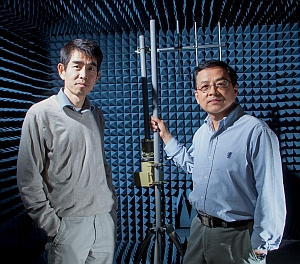Engineers at University of California in Riverside developed a method they say can double the efficiency of mobile wireless networks. Riverside electrical engineering professors Yingbo Hua and Ping Liang, with three graduate students, published their findings in a recent online issue of the journal IEEE Signal Processing Letters.
The proliferation of smartphones and tablets is forcing the wireless industry to expand the capacity of the limited mobile wireless spectrum that now carries high-bandwidth services, such as streaming video, along with voice and text. This spectrum crunch is expected to get even worse as cell phone users trade in their traditional handsets for smartphones and tablets. Mobile tablets, say the authors, generate 121 times more traffic than a traditional cell phone.
The Riverside team found a solution in creating a full-duplex radio communications service in the mobile wireless spectrum. Wireless devices today use half-duplex radio, which means signals are transmitted and received in two separate channels. Current devices, including those supporting 3G and 4G networks, need to separate incoming and outgoing signals to prevent them from interfering with each other, as well as ambient interference from cell phone towers.
Hua, Liang, and colleagues devised a solution they call time-domain transmit beamforming that allows the mobile device to hear a much weaker incoming signal while sending strong outgoing signals at the same frequency and at same time. Beamforming makes it possible to direct most of a transmitted signal from a group of radio antennae in a chosen angular direction, or calibrate a group of antennae to receive most signals in a chosen angular direction.
The researchers conducted experiments using current hardware and found their full-duplex method feasible with today’s radio-frequency equipment. The solution, they note, requires new digital components, but ones that can be retrofitted into the existing infrastructure. Liang and Hua believe cell towers are likely places to start implementing full-duplex radios, since they are less constrained by existing standards.
The technology could also be applied, say the researchers, to cognitive radio, a form of wireless communication that allows a mobile device to detect communications channels in use and those that are open, then move the transmission into the vacant channels. Cognitive radio would make it possble to redirect transmissions away from overloaded cellular frequency bands to military, amateur radio, and TV bands, which get less use.
Read more:
- Smartphones Found Feasible Tools for Telemedicine Images
- New Study to Examine Next Generation Mobile Networks
- Chip Set Developed for High Speed Wireless Data Transfers
- Mobile Tech Developer Raises $15M in Expansion Round
- Engineers Develop Full Duplex Wireless Technology
* * *


 RSS - Posts
RSS - Posts
[…] Method Devised to Improve Wireless Network Efficiency […]